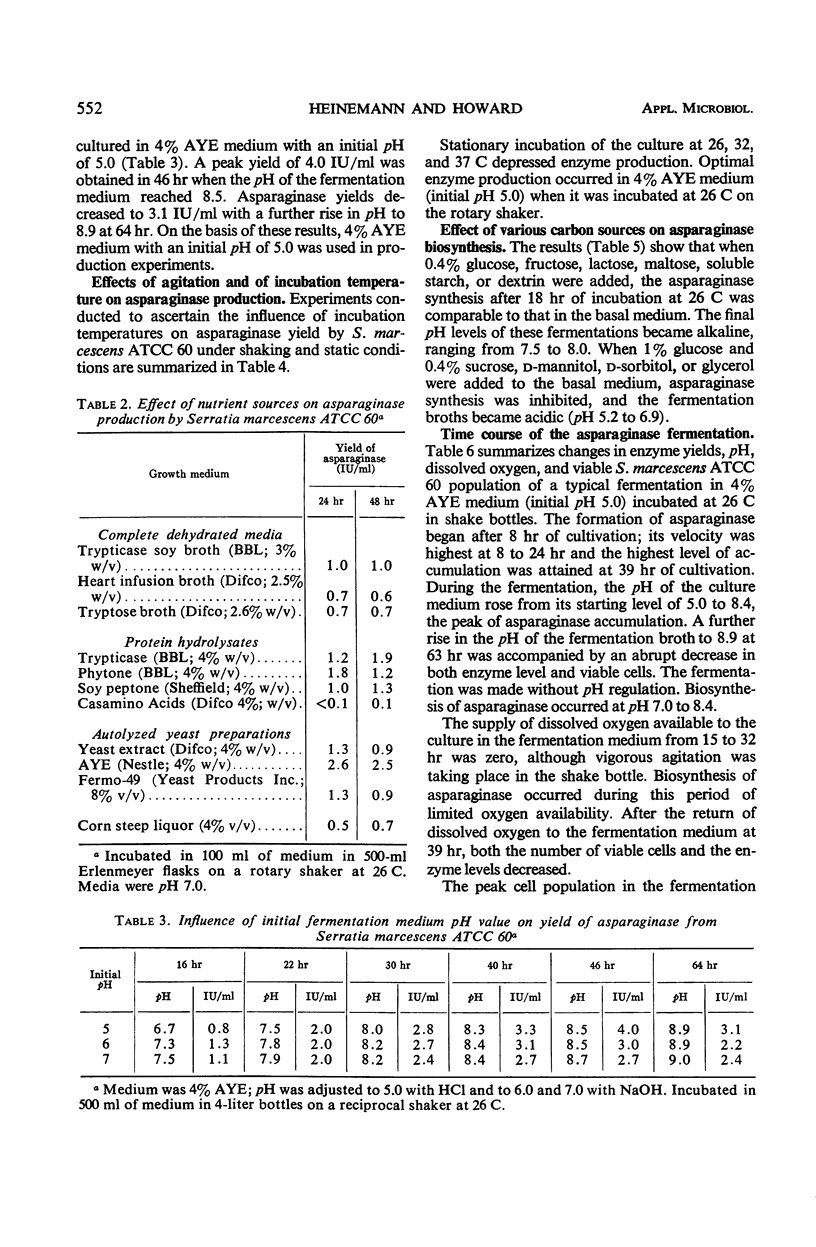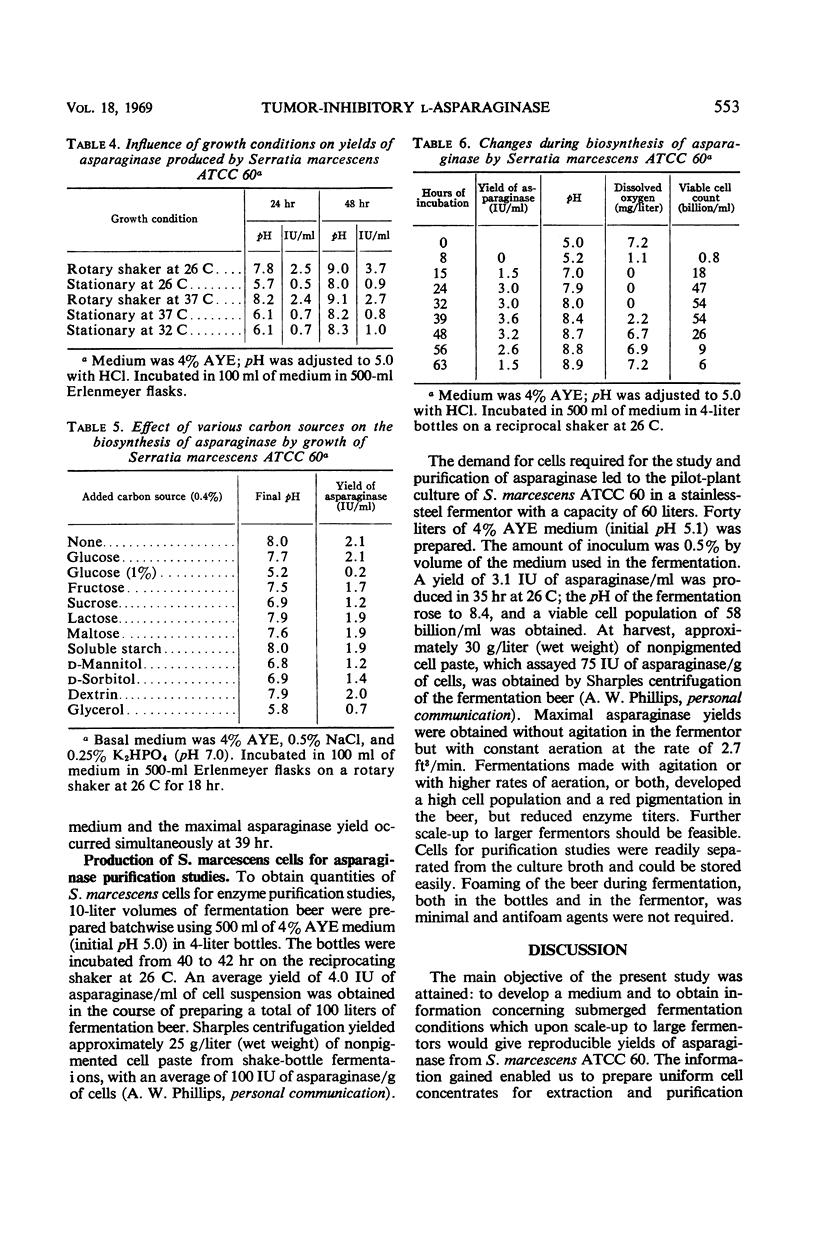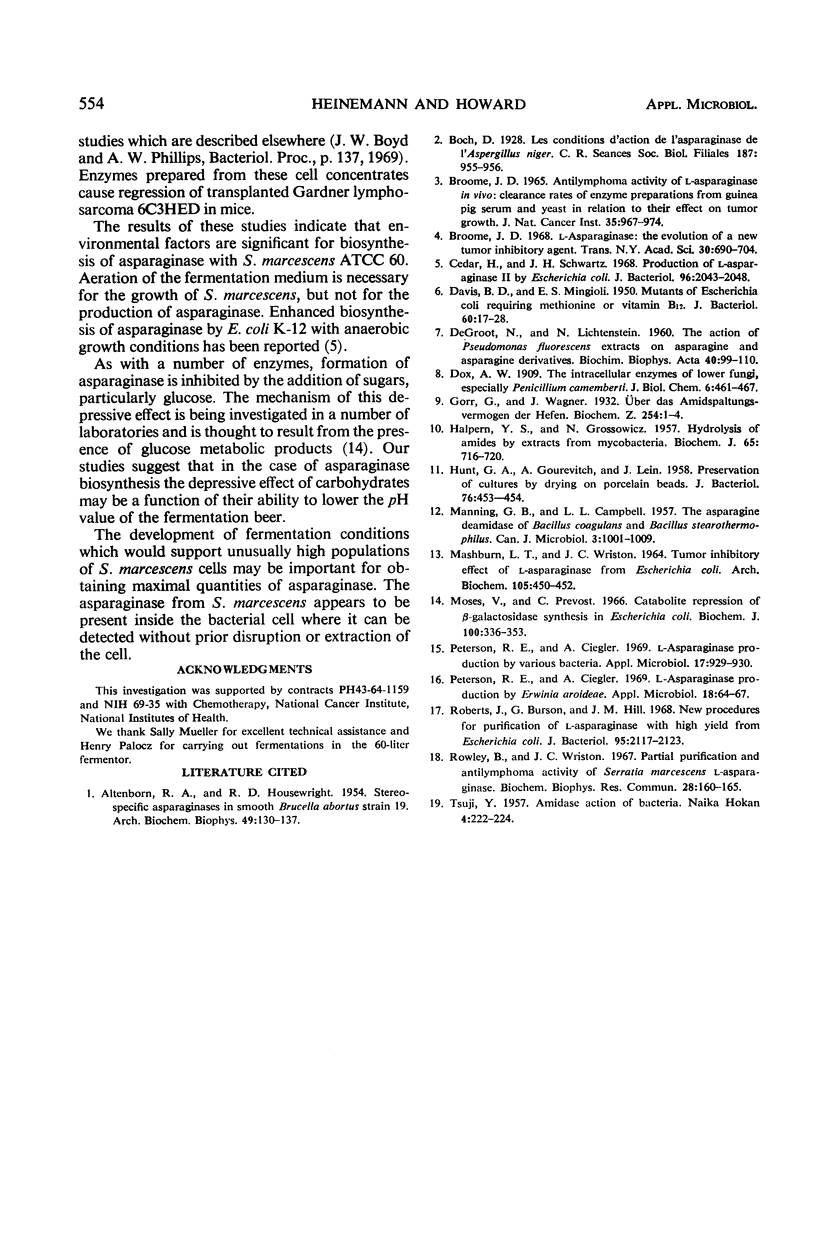Abstract
Production of a tumor-inhibitory asparaginase by submerged fermentation with Serratia marcescens ATCC 60 was studied to ascertain optimal nutritional conditions for large-scale production leading to enzyme purification studies. Five strains of S. marcescens were screened in shake-flask studies and were found to produce 0.8 to 3.7 IU/ml 48 hr after inoculation. The requirements for asparaginase production with S. marcescens ATCC 60, the high producing strain, included the following: 4% autolyzed yeast extract medium (initial pH 5.0), an incubation temperature of 26 C, and limited aeration for a zero level of dissolved oxygen during the fermentation. Addition of various carbohydrates to the fermentation medium did not enhance yields. The peak cell population in the fermentation medium and the maximal asparaginase yields occurred simultaneously. Highest enzyme yields were found when the pH of the fermentation cycle rose to approximately 8.5. Yields of 4 IU of asparaginase/ml of cell suspension have been obtained consistently in 40 to 42 hr from 10-liter volumes (500 ml/4-liter bottle) produced on a reciprocating shaker. Scale-up to a 60-liter fermentor yielded 3.1 IU/ml in 35 hr.
Full text
PDF




Selected References
These references are in PubMed. This may not be the complete list of references from this article.
- ALTENBERN R. A., HOUSEWRIGHT R. D. Stereospecific asparaginases in smooth Brucella abortus, strain 19. Arch Biochem Biophys. 1954 Mar;49(1):130–137. doi: 10.1016/0003-9861(54)90174-5. [DOI] [PubMed] [Google Scholar]
- Broome J. D. Antilymphoma activity of L-asparaginase in vivo: clearance rates of enzyme preparations from guinea pig serum and yeast in relation to their effect on tumor growth. J Natl Cancer Inst. 1965 Dec;35(6):967–974. [PubMed] [Google Scholar]
- Broome J. D. L-asparaginase: the evolution of a new tumor inhibitory agent. Trans N Y Acad Sci. 1968 Mar;30(5):690–704. doi: 10.1111/j.2164-0947.1968.tb02511.x. [DOI] [PubMed] [Google Scholar]
- Cedar H., Schwartz J. H. Production of L-asparaginase II by Escherichia coli. J Bacteriol. 1968 Dec;96(6):2043–2048. doi: 10.1128/jb.96.6.2043-2048.1968. [DOI] [PMC free article] [PubMed] [Google Scholar]
- DAVIS B. D., MINGIOLI E. S. Mutants of Escherichia coli requiring methionine or vitamin B12. J Bacteriol. 1950 Jul;60(1):17–28. doi: 10.1128/jb.60.1.17-28.1950. [DOI] [PMC free article] [PubMed] [Google Scholar]
- HALPERN Y. S., GROSSOWICZ N. Hydrolysis of amides by extracts from Mycobacteria. Biochem J. 1957 Apr;65(4):716–720. doi: 10.1042/bj0650716. [DOI] [PMC free article] [PubMed] [Google Scholar]
- HUNT G. A., GOUREVITCH A., LEIN J. Preservation of cultures by drying on porcelain beads. J Bacteriol. 1958 Oct;76(4):453–454. doi: 10.1128/jb.76.4.453-454.1958. [DOI] [PMC free article] [PubMed] [Google Scholar]
- MANNING G. B., CAMPBELL L. L., Jr The asparagine deamidase of Bacillus coagulans and Bacillus stearothermophilus. Can J Microbiol. 1957 Dec;3(7):1001–1009. doi: 10.1139/m57-111. [DOI] [PubMed] [Google Scholar]
- MASHBURN L. T., WRISTON J. C., Jr TUMOR INHIBITORY EFFECT OF L-ASPARAGINASE FROM ESCHERICHIA COLI. Arch Biochem Biophys. 1964 May;105:450–452. doi: 10.1016/0003-9861(64)90032-3. [DOI] [PubMed] [Google Scholar]
- Moses V., Prevost C. Catabolite repression of beta-galactosidase synthesis in Escherichia coli. Biochem J. 1966 Aug;100(2):336–353. doi: 10.1042/bj1000336. [DOI] [PMC free article] [PubMed] [Google Scholar]
- Peterson R. E., Ciegler A. L-asparaginase production by Erwinia aroideae. Appl Microbiol. 1969 Jul;18(1):64–67. doi: 10.1128/am.18.1.64-67.1969. [DOI] [PMC free article] [PubMed] [Google Scholar]
- Peterson R. E., Ciegler A. L-asparaginase production by various bacteria. Appl Microbiol. 1969 Jun;17(6):929–930. doi: 10.1128/am.17.6.929-930.1969. [DOI] [PMC free article] [PubMed] [Google Scholar]
- Roberts J., Burson G., Hill J. M. New procedures for purification of L-asparaginase with high yield from Escherichia coli. J Bacteriol. 1968 Jun;95(6):2117–2123. doi: 10.1128/jb.95.6.2117-2123.1968. [DOI] [PMC free article] [PubMed] [Google Scholar]
- Rowley B., Wriston J. C., Jr Partial purification and antilymphoma activity of Serratia marcescens L-asparaginase. Biochem Biophys Res Commun. 1967 Jul 21;28(2):160–165. doi: 10.1016/0006-291x(67)90423-8. [DOI] [PubMed] [Google Scholar]
- de GROOT, LICHTENSTEIN N. The action of Pseudomonas fluorescens extracts on asparagine and asparagine derivatives. Biochim Biophys Acta. 1960 May 6;40:99–110. doi: 10.1016/0006-3002(60)91319-6. [DOI] [PubMed] [Google Scholar]


